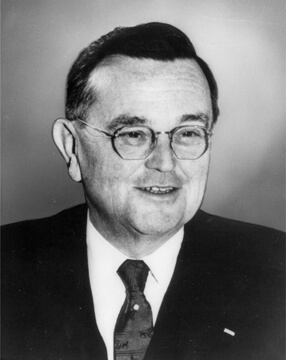Did You Know?: R. Games Slayter and Slayter Center
January 24, 2014
 |
|
R. Games Slayter, who graduated from Purdue in 1921 with a bachelor's degree in chemical engineering, is credited for a wide range of engineering accomplishments, including the development of Fiberglas. His $300,000 donation funded construction of Slayter Center. (Photograph by Owens Corning. Used by permission.) |
The Purdue alumnus whose $300,000 donation in 1963 funded Slayter Center's construction is credited for a wide range of engineering accomplishments, including the development of Fiberglas.
Born in 1896 in Argos, Ind., R. Games Slayter graduated in 1921 with a bachelor's degree in chemical engineering, according to documents from Archives and Special Collections. As an undergraduate, he played tuba in Purdue's "All-American" Marching Band.
Slayter spent the early part of his career at a company called Owens-Illinois Glass Co., based in Toledo, Ohio. While working for the company, Slayter created the course fibers that led to the production of the first commercial fiberglass product, according to documents housed at the University of Toledo.
In 1938, Slayter became the vice president of research and development for Owens-Corning Fiberglas Corp., which formed from Owens-Illinois and a company called Corning Glass Works. In that position, Slayter refined Fiberglas' production process to make it financially viable, the documents say. Slayter worked for the company, now known as Owens Corning, until his retirement in the 1960s.
Slayter held more than 90 patents in fiberglass technology. In 2006, he was inducted posthumously into the National Inventors Hall of Fame in Akron, Ohio.
Construction on Slayter Center finished in 1964, and its formal dedication ceremony took place May 1, 1965. Slayter Hill, which rises above the structure, seats up to 4,000 for a show.
Slayter Center's stage can accommodate more than 100 musicians. The structure's side and back walls are made up of stele reminiscent of the stone monoliths of Stonehenge in England.
The first outdoor concert was held at Slayter Center on Oct. 10, 1964, following the Purdue football team's 28-7 victory against Wisconsin. Slayter attended, and he expressed great satisfaction with the building's acoustics, according to the October 1964 minutes of the Board of Trustees.
Five days later, on Oct. 15, 1964, Slayter died of a heart attack, the minutes say. The Purdue Research Foundation's executive committee and the Board of Trustees both recorded memorial resolutions.
Writer: Amanda Hamon, ahamon@purdue.edu, 49-61325
